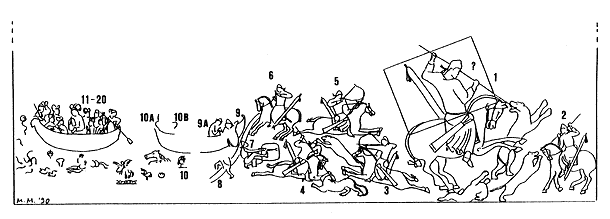
| Court art of Sogdian Samarqand in the 7th century AD | |||||||||||||
| Home | General | Western Wall | Northern Wall | Eastern Wall | Southern Wall | Bibliography | |||||||
 |
|
|||||||||||||||||||||||||||||||||||||||||||
Northern wall

The northern wall murals can be divided into a left and a right part. There are no indications of registers more than the lowermost although they certainly once existed.
Alltogether the paintings reflect a Chinese milieu. The left part of the remains depicts a water panorama with boats, whereas the right part shows a great composition of Chinese imperial hunting.
The water scene probably means a broad river rather than a sea as is indicated by a dark winding shoreline moving from the lower left centre to the upper right. This compositional effect was certainly adapted from Tang dynastic landscape painting. Figures 11-20 in the first boat were interpreted by Al'baum as a Chinese princess with her suite on a wedding journey. Al'baum's suggestion seems to be right.
If one takes these interpretations for granted, the questions are: What about the destination of this wedding journey? And who was the groom?
Al'baum and others thought that the princess was on the way to marry the ruler of Samarqand. In our opinion this is very unlikely. From the Chinese records we have no information about some event of this kind that would fit with the span of time we have established for the paintings, i.e. the years shortly before or after AD 650 (cp. our observations on the western wall).
But the Tang shu gives another interesting account: In AD 646 the Western Turk Yabghu-Qaghan Shekui asked the Chinese emperor Taizong for a princess. As we remember, this Shekui should have been the Turkish ruler depicted on the western wall. Finally this marriage was never realized; in AD 648 Chinese forces took Kucha...
Several scholars have denied that the Afrasiab painting depicts a Chinese princess. Instead they thought the person to represent a more inferior female. But in this special case the weakness of some details should not be overemphasized: As we have mentioned, the marriage remained a theoretical one and the princess never came to the Turks or even to Samarqand. Consequently the Sogdian painters did not see her and her princely outfit in reality.
Tang Taizong died in the year AD 649. At this point we have to remember that the Chinese account of king Varxuman, given for the years 650-655 (reign of emperor Gaozong), does not refer to the enthronement of the king, i.e., he already acted as a king when he was appointed governor by the emperor. Thus, the paintings in our Afrasiab hall could well have been created very close to a date around AD 649.
 |
|
|||||||||||||||||||||||||||||||||||||||||||